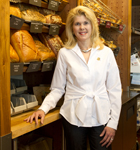
When we sat down to interview Jeffrey Bucklew, chief human resources officer of IDEX, he was celebrating his first 100 days. In a short time, Bucklew has accomplished a lot for the $2 billion global industrial manufacturer. Charged with building a culture of talent, and in particular great business-operation leaders, Bucklew is engaged in a multiyear strategy of upgrading the company’s HR function. We wanted to hear how it’s getting done.
What was the first directive you were given by Andrew Silvernail, IDEX’s CEO?
That we need to find a way to develop five to seven general managers every year to support the growth of the company. IDEX has 50 business units under three segments. This creates a lot of opportunity for general managers who can run their own businesses. The GMs in those corner offices play a critical role, and if we can get that right, everything else should fall in line.
You describe the ideal HR leader as a trusted business partner that happens to do HR. How do you achieve that?
Through clear expectations and direct feedback. We have three operational HR leaders for each of our business segments. We start with those HR leaders, first and foremost understanding how we’re going to assess their performance. Next, they need to feel like they’ve got a relationship with their operating leader of being a trusted adviser—someone they look to and seek out to help run their business and solve issues. Then they need to have that same relationship model with whoever they are supporting. If they don’t, then the goals don’t get achieved. That thread of connection generates trust.
What is your big initiative in HR to align with the CEO?
Silvernail’s vision is called “The 15/15 vision.” That means we’re trying to achieve 15 percent top-line revenue growth and a 15 percent return on invested capital. It’s relatively easy to do one or the other; it’s an interesting balancing act to do both, and it’s not a one-year goal. HR achieves that by building great global teams, executing a leadership excellence program, succession planning, and focusing on driving profitable growth, both by running the business more efficiently and by finding the right acquisitions.
How do you focus 7,000 employees on one singular mission?
We prioritize, and that includes deciding what we’re not going to focus on as much as what we are. That leaves selecting the items that are going to make the biggest impact. So when I put my HR hat on, we came up with five things we’re going to focus on within HR: a leadership excellence program, a talent review process, a focus on filling our top open positions, analyzing our sales compensation plans to ensure they’re driving us toward our goals, and building out our acquisition-integration capability.
In what ways are you centralizing HR’s function?
We recently spent some time at Whirlpool looking at how they’re using technology to forecast future talent needs. They’ve gone real deep and can slice and dice their talent knowledge in many ways, and they repackage this information for leadership teams. That experience showed us what we need to invest in here at IDEX. We’re currently utilizing Success Factors, a software as a service that Whirlpool uses as their HR backbone. It’s robust enough to handle where we want to go in terms of managing our talent. Having centralized access to that information will indirectly help us achieve our 15/15 goals over the long term.
Do you have a personal philosophy that defines your management?
I believe the more you simplify what you can do in HR—making it user friendly—the more impactful it will be. Simplifying issues helps solve them.

